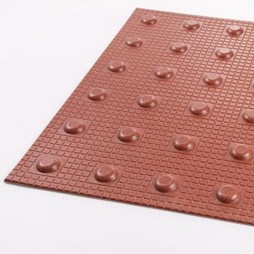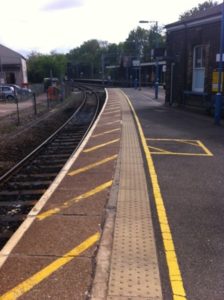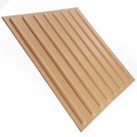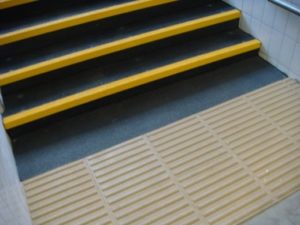Everything you ever wanted to know about TACTILES, but were too confused to ask…
Well, they are more than just a stick down product!
What is Tactile Paving?
Tactile Paving is the term used for a range of paving units that bear distinctive, raised surface profiles which are designed to be detectable by both sighted and visually impaired pedestrians.
What do they do?
Tactile paving tiles are used to convey important information about the environment to visually impaired people. For example, hazard warning, directional guidance, or the presence of an amenity. Research has shown that visually impaired people can reliably detect, identify, and remember a limited number of different tactile paving surfaces and the meanings assigned to them. Visually impaired people are becoming increasingly mobile, and it is therefore very important that conflicting or confusing information is not conveyed. Each type of tactile paving surface should be exclusively reserved for its intended use and consistently installed in accordance with available guidance.
What are they made of?
The tiles are made from a hard-wearing stone and resin composite moulded to create paving which will outperform equivalent concrete product. Tests conducted at the Transport Research Laboratory on product conditioned at 40ºC found no measurable loss in height at the end of a scuffing test.
What are the advantages in using these instead of heavy slab type tactile?
- Rapid installation, reduced disruption, and labour costs
- No excavation is required for paving so no disposal expenses. Small surface irregularities can be covered with the adhesive to ensure no cavities are left beneath the tiles.
- Tactile paving tiles are light in weight and are easy to handle and cut with no hot works required
- No requirement for plant machinery and associated access issues and expense
- Harder wearing paving than concrete alternatives
- Will not crack like concrete, preventing future trip hazards, stone/resin tiles and adhesive permanently flexible
- High slip resistance in dry or wet conditions
- All tactile paving tiles are UV tested with no colour fade
- Freeze-thaw tested
- Fast curing colour matched adhesive, surfaces ready to use within 2 hours
- Can be installed even in damp conditions
- Adheres to all standard paving surfaces
- Quality assured – manufactured to BS EN ISO 9001-2000
When put to the test…
A comparative wear test was carried out by Building Investigation and Testing Services (Redhill) against a concrete blister slab and found that tactile paving had 7 times greater wear resistance than the equivalent concrete product.

What are the differences in tactile paving and where should they be used?
Pedestrian Blister Tactile
The Pedestrian Blister tactile should be used at controlled crossings and buff blister tactile should be used at uncontrolled crossings. Where the surrounding paving or carriageway is the same colour as the tactile paving to be used a contrasting border, a minimum of 150mm wide, around the tactile paving surface should be used. The GRP blister surface of the tiles provides a warning to visually impaired people. The surface is therefore an essential safety feature for this group of road users at pedestrian crossing points, where the footway is flush with the carriageway to enable wheelchair users to cross unimpeded.
Rail Platform Blister Tactile
The offset blister tactile is also known as the Platform Edge (Off-Street) Warning Surface. “The purpose of this surface is to warn visually impaired people of the edge of all off-street railway platforms.” – Department for Transport. The blister surface can be read by foot or cane, warning of the approach to a rail platform edge. The off-set blister tactile surface consists of flat-topped domes (blisters), spaced 66.5mm apart from the centre of one dome to the next.

Corduroy Hazard Warning Tactile
The purpose of the corduroy surface tactile is to warn visually impaired people of the presence of specific hazards: steps, level crossings or the approach to the on-street light rapid transit (LRT) platforms. It is also used where a footway joins a shared route. It conveys the message ‘hazard, proceed with caution.’ The profile of the corduroy tactile surface comprises rounded bars running transversely across the direction of pedestrian travel.

The corduroy tactile can be used for any situation (other than pedestrian crossings) where visually impaired individuals need to be warned of a hazard, such as:
- the top and bottom of stairs
- at the foot of a ramp
- at a level crossing
- where people may unintentionally walk directly onto the platform at a railway station
- where a footway joins a shared route

To find out more about our anti-slip solutions, click here, or for more information on the variety of products we provide, give us a call on 02380 406796 or contact us here.

